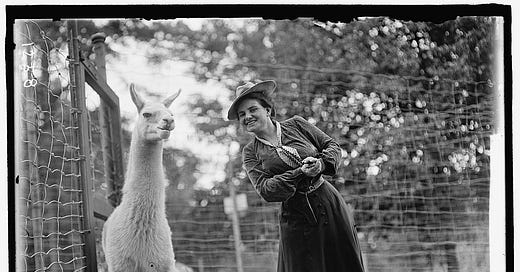"There is no reason why a woman cannot go wherever a man goes and further. If a woman be fond of travel, if she has love of the strange, the mysterious and the lost, there is nothing that will keep her at home. All that is needed for it as in all other things is the driving passion and the love. And as for being injured because she is a woman, that sounds rather a stupid notion to me. She has proved that she can go where men go and that lack of caution (which is a little of every woman) will take her out of the tent to discover something else while her husband is sleeping covered up to the ears in blankets and fur." - Harriet Chalmers Adams
Harriet’s words may have raised eyebrows, given the many restrictions placed on women living in the late 19th and early 20th centuries. But she did live as she spoke: daring and unafraid, driven by a desire for adventure and a deep curiosity about the world and its people.
For Harriet, such a lifestyle began during her earliest years. Born on October 22, 1875, in Stockton, California, she spent her childhood going on outdoor adventures with her father. About which she wrote,
"My beloved father was a Scottish Canadian, and when I was a girl he and I trailed his Rockies together. With ponies & one cargo animal, we set out every June for the high mountains, either in California or in Canada, and camped by many a highland lake. We covered our California Sierras in this way from Oregon to Mexico, when the high places, now well known, were virtually unexplored."
These trips inspired Harriet. As a result, she "wished to go to the ends of the earth and to see and study the people of all lands.”
In 1899, Harriet married Franklin Pierce Adams. Rather than settling into a conventional life, she found in him a partner willing to pack a bag and follow her into the unknown. After some initial travels throughout California, in 1904, they set off on their first great international adventure: a years-long expedition across South America. They trekked through the Andes, traced the paths of Spanish conquistadors, explored the Amazon, and marveled at the ruins of Machu Picchu. She recorded everything, including this note from that first year,
"Night came with a heavy storm. Narrow escape on old trail which we took by mistake. Came to meeting of rivers but could not cross as rivers very high and no bridge. Out on ledge in storm all night. The adventure I have wanted I guess and it's kind of exciting ... A long long night so wet and cold. No sleep or food."
The couple traveled more than 40,000 miles over the next three years.
Harriet's documentation caught the attention of National Geographic, who hired her. At the magazine, she became a well-known voice, writing stories that brought her worldwide travels into American homes, transforming distant places into vivid, tangible realities. The stories were a delight to read. And as a result of the stories, Harriet also became a well-known public speaker. As one program handbill proclaimed about her, "there is no greater lecturer today, man or woman, who possesses a more magnetic hold over the audience nor a greater personal charm than she."
Then, when World War I broke out in 1914, Harriet refused to sit idly by. Using her skills as an explorer and journalist, she became a war correspondent for Harper’s Magazine, reporting from the front lines in France. She was one of the only women given access.
While her reporting did not typically include combat photography, she wrote vivid, on-the-ground accounts of soldiers' lives, wartime Europe's atmosphere, and the conditions behind the front lines. She visited hospitals, military camps, and battlefield-adjacent zones, often describing the emotions and social fabric of war-torn areas. This was her gift. Harriet humanized the war, highlighting the courage and suffering of ordinary people. It stood in contrast to the more formal war dispatches of the time.
After the war, Harriet continued living out her adventurous dreams until she passed away in 1937.
Note: If you’d like to support our work with a contribution, you can now buy us a coffee on Ko-fi. Thank you in advance for your support 💙
Sources:
David, Kathryn. "Harriet Chalmers Adams: Remembering an American Geographer." The California Geographer, Volume 49, 2009, https://scholarworks.calstate.edu/downloads/hx11xj601
Harris & Ewing, photographer. ADAMS, MRS. FRANKLIN, NEE HARRIET CHALMERS. AT ZOO WITH LLAMA. Photograph. Retrieved from the Library of Congress, <www.loc.gov/item/2016863766/>.
"Harriet Chalmers Adams." Women in Exploration, https://womeninexploration.org/timeline/harriet-chalmers-adams
Strochlic, Nina. "A 40,000-mile journey was nothing for this 19th-century female explorer." March 16, 2020, https://www.nationalgeographic.com/history/article/40000-mile-journey-was-nothing-for-19th-century-female-explorer





We could use a cohort of her stock today. This was a great, inspiring piece as have the previous snapshots for a month allegedly honoring women's history. Too many are still comfortable if women stay in history books where they belong and don't go messing around out here. Much like "saviors" who are honored as long as they stay safely hung on the wall.
I live close to Stockton, CA and have never heard of Harriet! Thank you for the story about this amazing woman!